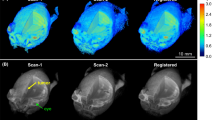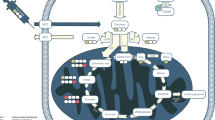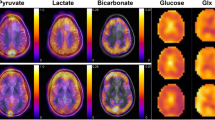Abstract
The effects of combretastatin A4 prodrug on perfusion and the levels of 31P metabolites in an implanted murine tumour were investigated for 3 h after drug treatment using nuclear magnetic resonance imaging (MRI) and spectroscopy (MRS). The area of regions of low signal intensity in spin-echo images of tumours increased slightly after treatment with the drug. These regions of low signal intensity corresponded to necrosis seen in histological sections, whereas the expanding regions surrounding them corresponded to haemorrhage. Tumour perfusion was assessed before and 160 min after drug treatment using dynamic MRI measurements of gadolinium diethylenetriaminepentaacetate (GdDTPA) uptake and washout. Perfusion decreased significantly in central regions of the tumour after treatment. This was attributed to disruption of the vasculature and was consistent with the haemorrhage seen in histological sections. The mean apparent diffusion coefficient of water within the tumour did not change, indicating that there was no expansion of necrotic regions during the 3 h after drug treatment. Localized 31P-MRS showed that there was decline in cellular energy status in the tumour after treatment with the drug. The concentrations of nucleoside triphosphates within the tumour fell, the inorganic phosphate concentration increased and there was a significant decrease in tumour pH for 80 min after drug treatment. The rapid, selective and extensive damage caused to these tumours by combretastatin A4 prodrug has highlighted the potential of the agent as a novel cancer chemotherapeutic agent. We have shown that the response of tumours to treatment with the drug may be monitored non-invasively using MRI and MRS experiments that are appropriate for use in a clinical setting.
This is a preview of subscription content, access via your institution
Access options
Subscribe to this journal
Receive 24 print issues and online access
$259.00 per year
only $10.79 per issue
Buy this article
- Purchase on Springer Link
- Instant access to full article PDF
Prices may be subject to local taxes which are calculated during checkout
Similar content being viewed by others
Author information
Authors and Affiliations
Rights and permissions
About this article
Cite this article
Beauregard, D., Thelwall, P., Chaplin, D. et al. Magnetic resonance imaging and spectroscopy of combretastatin A4 prodrug-induced disruption of tumour perfusion and energetic status. Br J Cancer 77, 1761–1767 (1998). https://doi.org/10.1038/bjc.1998.294
Issue Date:
DOI: https://doi.org/10.1038/bjc.1998.294
This article is cited by
-
Development of multifunctional Overhauser-enhanced magnetic resonance imaging for concurrent in vivo mapping of tumor interstitial oxygenation, acidosis and inorganic phosphate concentration
Scientific Reports (2019)
-
Power Doppler ultrasound and contrast-enhanced ultrasound demonstrate non-invasive tumour vascular response to anti-vascular therapy in canine cancer patients
Scientific Reports (2019)
-
Anti-tumor activity and mechanisms of a novel vascular disrupting agent, (Z)-3,4′,5-trimethoxylstilbene-3′-O-phosphate disodium (M410)
Investigational New Drugs (2011)
-
Microtubule-binding agents: a dynamic field of cancer therapeutics
Nature Reviews Drug Discovery (2010)
-
Technology Insight: water diffusion MRI—a potential new biomarker of response to cancer therapy
Nature Clinical Practice Oncology (2008)



